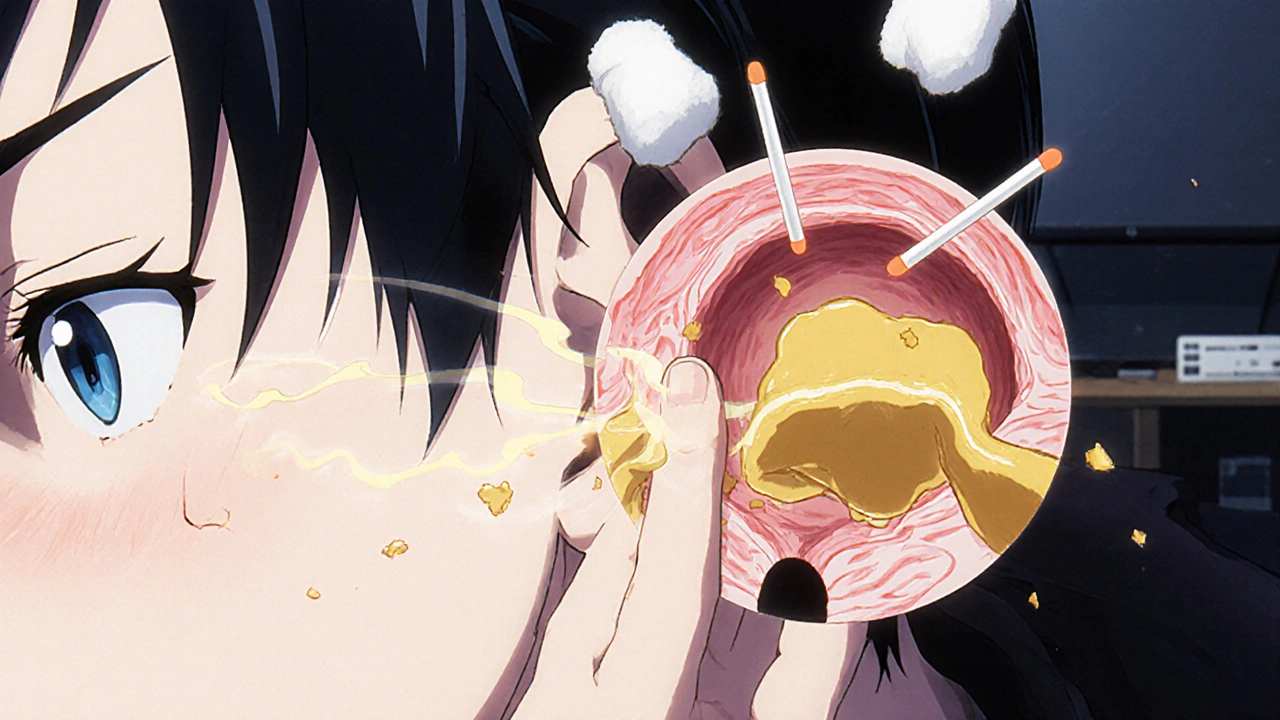Most people think earwax is just dirt that needs cleaning out. But your ears aren’t meant to be scrubbed. In fact, trying to clean them with cotton swabs, bobby pins, or ear candles often makes things worse. Earwax impaction - when wax builds up and hardens in the ear canal - affects about 6% of adults, and that number jumps to 30% in people with developmental disabilities or over age 65. It’s not rare. It’s common. And it’s often self-inflicted.
What Earwax Impaction Really Feels Like
You might not realize your hearing has gotten worse until you’re struggling to hear the TV, or someone calls your name and you don’t turn around. That’s not just aging. It could be earwax blocking the sound. The most common symptom is hearing loss - reported in 65% of cases. But it’s rarely just that.Many people feel a dull pressure or fullness in the ear, like it’s plugged with cotton. Others get earaches, ringing (tinnitus), or even dizziness. Some even develop a cough. Yes, a cough. That’s because the ear and throat share nerve pathways. When wax presses on the canal, it can trigger a reflex that makes you cough.
Drainage or a strange odor from the ear? That’s a red flag. It doesn’t mean you’re dirty - it means the wax has trapped moisture and bacteria, possibly leading to infection. Symptoms usually build slowly over one to three weeks. Most people have at least two symptoms together. If you’ve been using cotton swabs and now your ear feels blocked, it’s not a coincidence. It’s the cause.
Why Cotton Swabs Make It Worse
It’s the most common mistake. You see wax at the opening of your ear, so you reach in. But here’s the truth: earwax doesn’t just sit there. Your ears are self-cleaning. The skin in your ear canal slowly moves outward like a conveyor belt, carrying wax and dead skin with it. Jaw movement from talking and chewing helps push it out naturally.When you stick a cotton swab in, you’re not cleaning - you’re pushing wax deeper. NHS England data shows that 60-70% of earwax impactions are caused by cotton swabs. That’s not a myth. That’s a medical fact. And it’s not just swabs. Hearing aids, earplugs, and even excessive ear hair can trap wax and stop it from moving out. People with narrow or oddly shaped ear canals are more likely to get blocked. Age plays a role too - as we get older, earwax becomes drier and harder to clear naturally.
And here’s the kicker: if you’ve had ear surgery, a perforated eardrum, or tubes in your ears, home remedies can be dangerous. Yet social media is full of videos showing people scraping wax out with spoons or using suction devices bought online. Those TikTok videos have over 1.2 billion views. The FDA has logged over 12,500 ear injuries from these unsafe practices between 2018 and 2022 - including 3,000 cases of torn eardrums.
How Doctors Diagnose It
You can’t diagnose earwax impaction by looking in the mirror. You need a professional tool called an otoscope - a small lighted scope that lets a doctor see deep into your ear canal. That’s the only way to know for sure if wax is blocking your ear and if it’s actually causing your symptoms.Here’s something surprising: up to 40% of people have visible wax in their ears during routine checkups, but they have no symptoms. That’s not impaction. That’s normal. Impaction only counts when the wax is causing problems - like hearing loss, pain, or dizziness - and it’s blocking the view of the eardrum. That’s why doctors don’t remove wax just because it’s there. They remove it because you’re suffering.
They also rule out other issues. About 22% of people who think they have earwax actually have something else - like an ear infection, a skin growth called cholesteatoma, or even jaw joint problems. A good doctor will ask about your history, check your eardrum movement with a puff of air (that’s what a pneumatic otoscope does), and only then decide on treatment.
Safe Ways to Remove Earwax
There are three proven, safe methods - and only one you should try at home.First: Soften the wax at home
If you’re not in pain and your hearing is only slightly affected, try this: lie on your side and put 2-3 drops of olive oil, almond oil (if you’re not allergic), or mineral oil into your ear. Stay like that for 5-10 minutes. Do this 3-4 times a day for 3-5 days. Then gently wipe the outside of your ear with a damp cloth. Don’t stick anything inside.
Studies show this works for about 58-65% of people. It’s not instant. But it’s safe. Avoid hydrogen peroxide - it can irritate the skin and cause more swelling. And never use ear candles. They don’t work. The FDA has banned them as misbranded devices since 2010. The wax you see in the candle after? That’s from the candle itself, not your ear.
Second: Professional removal
If home softening doesn’t help, or if you’re in pain, see a doctor. There are three professional methods:
- Manual removal - Using tiny tools like curettes or forceps. It’s quick, precise, and 92% effective in one visit.
- Ear irrigation - Warm water or saline is gently flushed into the ear. It works for 85% of people, but it’s not safe if you’ve had a ruptured eardrum or ear surgery.
- Microsuction - A small vacuum removes wax under direct vision. It’s the gold standard - 96% effective, no water involved, and safe even if you’ve had ear problems before. Most patients say they hear better immediately.
Microsuction is becoming more common in clinics across the UK and US. Patients give it a 92% satisfaction rate on review sites. Irrigation gets 85%. Both are done in under 20 minutes. Most people leave with clear ears and better hearing the same day.
What Not to Do
Here’s a short list of things you should never do:- Don’t use cotton swabs, hairpins, or toothpicks inside your ear.
- Don’t try ear candling. It’s dangerous and fake.
- Don’t use home suction devices sold online. They’re unregulated and can rupture your eardrum.
- Don’t ignore symptoms if you have diabetes, a weakened immune system, or a history of ear surgery.
- Don’t wait until you’re in pain. If your hearing has changed, get it checked.
One Reddit user summed it up: “Never put anything smaller than your elbow in your ear.” It’s crude, but it’s true.

When to See a Doctor
You don’t need to rush to the clinic if you just feel a little full. But if you have any of these, book an appointment:- Hearing that’s noticeably worse than usual
- Ear pain or pressure that doesn’t go away
- Dizziness or balance problems
- Ringing in the ear that’s new or getting louder
- Drainage, odor, or bleeding from the ear
- You use hearing aids and notice reduced performance
And if you’ve tried oil drops for five days with no improvement - stop. It’s time for professional help.
The Bigger Picture
Earwax impaction isn’t just a minor annoyance. It’s a leading cause of reversible hearing loss - especially in older adults. In the US, over 12 million doctor visits each year are for this exact problem. The cost? Over $116 million in direct medical expenses.But here’s the good news: most cases are preventable. You don’t need to clean your ears. You just need to stop poking them. The ear is designed to clean itself. All it needs is space and time. If wax builds up, oil drops can help. But if it’s hard and stuck - let a professional handle it.
With new tech like the Eareto OtoSonic device (recently cleared by the FDA for home use), we may see fewer cases in the future. But until then, the best advice remains simple: don’t insert things. Don’t guess. And if something feels off - get it checked.
Can earwax impaction cause permanent hearing loss?
No, earwax impaction does not cause permanent hearing loss. The hearing loss it causes is temporary and fully reversible once the wax is removed. However, if left untreated for a long time, the blockage can lead to secondary infections or damage to the ear canal, which may affect hearing. That’s why it’s important to get it checked if symptoms last more than a week or get worse.
Is earwax removal painful?
Professional earwax removal is rarely painful. Microsuction feels like a gentle vacuum and may be slightly noisy, but most patients describe it as odd, not painful. Irrigation can feel strange if the water isn’t warmed properly, but it shouldn’t hurt. If you feel sharp pain during any procedure, tell the provider immediately - it could mean the eardrum is irritated or damaged.
How often should I get my ears cleaned?
You don’t need regular cleanings unless you’re prone to buildup. Most people never need professional ear cleaning. If you use hearing aids, have narrow ear canals, or produce very hard wax, your doctor might recommend checkups every 6-12 months. But if you have no symptoms, don’t get your ears cleaned just because you think you should. Less is more.
Can I use baby oil to soften earwax?
Yes, baby oil (mineral oil) is safe and effective for softening earwax. Use 2-3 drops in the affected ear, lie on your side for 5-10 minutes, and repeat 3-4 times a day for up to 5 days. Avoid it if you’re allergic to mineral oil. Don’t use it if you have a ruptured eardrum or ear tubes - always check with a doctor first.
Why does my ear feel blocked even after using oil drops?
Oil drops soften wax but don’t remove it. If the wax is hard and packed tightly, it may still be blocking your ear even after softening. You may need professional removal. If you’ve used oil for 5 days with no improvement, see a doctor. Don’t keep trying - you risk pushing wax deeper or irritating your skin.
Are over-the-counter earwax removal kits safe?
Kits that contain carbamide peroxide (like Debrox or Murine) are generally safe for short-term use if you follow the instructions. They work for about 65% of people. But avoid kits that include syringes for irrigation unless you’ve been trained. The real risk comes from people using them too often or too aggressively. If you have any history of ear problems, skip these entirely and see a professional.
Can earwax impaction cause tinnitus?
Yes, earwax impaction can cause or worsen tinnitus - the ringing or buzzing in the ear. When wax blocks the ear canal, it changes how sound travels inside, which can trigger or amplify internal noises. Once the wax is removed, tinnitus often improves or disappears. If it continues after removal, see a specialist to rule out other causes.
Earwax isn’t the enemy. Trying to force it out is. Your ears know how to take care of themselves. Your job is just to not mess with them.






